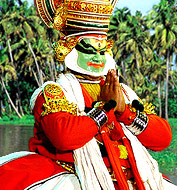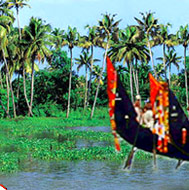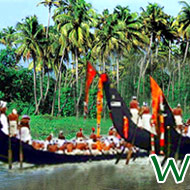People of Kerala have deep cultural roots and have preserved their traditions not only in the form of scriptures, visual art, and performing arts, but also in the form of architectural marvels, like temples, forts, and churches. Blessed with a rich stock of historic and cultural monuments, Kerala represents a unique mixture of various styles of architecture, sculpture, and art. The traditional architectural styles of Kerala include the styles based on the scriptures and silpa sasthras. The structures built according to these traditional architectural styles are a true portrait of the mythological structures embedded in the sasthras. Some popular architectural styles include 'Nalukettu' and 'Ettukettu'. A strong influence of Hindu architecture can be seen in the mosques, cathedrals, and other monuments of Kerala, though in regions like Fort Kochi, an interesting mix of Chinese, European, Jewish, and Arabic styles are also noticeable.
The monuments are adorned with mural paintings and carvings which are as beautiful and serene as the peaceful golden beaches and lagoons of Kerala. The traditions are passed on to generations by means of these intricately carved and sculpted monuments. Though the monuments are not as they were in the bygone eras as they have been refurbished time and again to keep the beauty intact and in the process, but they have become the bards of architectural history of Kerala. The once majestic and massive forts, which witnessed the rambling tussles between dynasties, stand placid and frozen in time, absolutely beautiful, marvelous, and distinctive.
Bolghatty Island
Bolghatty Island, as it is locally known, is a minuscule island in the historic town of Kochi in Ernakulam district, Kerala. This small yet lush and beautiful island is situated near the mouth of Kochi Harbor, just off the Kochi Marine Drive. A long and narrow palm fringed island, you have to take a ferry ride from Ernakulam, which itself is a pleasing experience.
Chendamangalam Monuments
Nothing more can be a perfect example of religious tolerance and peaceful co-existence than the small yet impressive town of Chendamangalam. A church, a temple, a mosque, and the remains of a Jewish synagogue all sited in close vicinity of each other exhibit true Indian sovereignty. The rare combination of three rivers, seven inlets, hillocks, and vast expanse greens makes this destination a unique geographical experience.
Edakkal Caves
The thick flora and fauna of the Ambukutty mountain range give way to the primitive Edakkal Caves, about 25 km from Wayanad district, Kerala in the Western Ghats. Believed to be one of the earliest centers of human habitation, the caves lie 1200 meters above sea level and are a window to many queries about the evolution and way of life of human beings.
Fort Kochi
A jewel in the crown of Kerala, Fort Kochi is located about 13 km from Ernakulam town. With one of the finest natural harbors in the world, Kochi has become a sanctuary for seafaring visitors from all across the world. The European heritage and true cosmopolitan temperament blend to pamper your travel steps and soothe your senses. Kochi is considered to be one of the first European townships in India when the Portuguese settled here in the 15th century.
Kochi Synagogue
The famous Kochi Synagogue is located at Fort Kochi, about 10 km from Ernakulam in Kerala. Constructed in 1568 by the Malabar Yehudan people or Cochin community, the synagogue is the oldest working in the Commonwealth of Nations. Although it was partially destroyed in a shelling during the Portuguese raid in 1662, but was rebuilt two years later by the Dutch.
Koyikkal Palace
Just 18 km off the capital city of Thiruvananthapuram on your way to Ponmudi hill station and Courtalam Waterfalls, you will find a charming two-storied palace, known as the Koyikkal Palace. Actually built for Umayamma Rani of the Venad royal family between 1677 and 1684, the palace is constructed in the traditional nalukettu style, boasting of slanting gabled roofs and an inner courtyard.
Krishnapuram Palace
A unique and distinct example of Kerala style of architecture, the Krishnapuram Palace is situated at Kayamkulam, 47 km from Alappuzha. Coupled with narrow corridors, gabled roofs, and dormer windows, this historical palace was the center of activity for the Kayamkulam king for several centuries. The king of Kayamkulam ruled his tiny kingdom until he was defeated by King Marthanda Verma of Travancore.
Kunchan Smarakam
Different from the other historical monuments, Kunchan Smarakam is a memorial built in the memory of the famous poet of Kerala, Kunchan Nambiar. The Kunchan Smarakam is situated in Lakkidi, about 30 km from the Palakkad district. Apart from being a centre of learning for scholars, the fort is a great place to enjoy natural beauty encircling the historic monument.
Mattancherry Palace
Built by the Portuguese in 1557, Mattancherry Palace was presented to Raja Veera Kerala Varma of Kochi. The Dutch carried out a few renovation work and extension of the structure of the palace in 1663. Since then, the palace is popularly known as the Dutch Palace. Following the Dutch, a few rajas, residing at the palace, also made improvements, supplementing it with the unique tints from various cultures, thereby giving it a colorful yet organized look.
Padmanabhapuram Palace
A splendid wooden piece of architecture situated at the land's end of mainland India. Such is the feel and locality of Padmanabhapuram Palace, which lies at Padmanabhapuram Fort at Thuckalay in the Kanyakumari district, the end point of India, of Tamil Nadu. A typical specimen of Kerala's indigenous style of edifice, this magnificent palace was once the home of the Rajas of the erstwhile Travancore.
Poonjar Palace
Poonjar Palace truly stands as a glorious proof to the regal magnificence of a bygone era. The palace stands tall with all its majesty and magnificence, narrating the stories of the past. Poonjar is a royal place that was once inhabited by the royalties of Kerala. The palace is an explicit example of traditional Kerala architecture with its sloping roofs and carved walls, adorned with paintings and artifacts.
Shakthan Thampuran Palace
Shakthan Thampuran Palace, also referred to as Vadakkekara Palace, is situated in Thrissur district of Kerala. A landmark in the chronicles of the Perumpadappu Swaroopam, the erstwhile ruling dynasty of Kochi, the palace was built in 1795 in Kerala-Dutch style by Ramavarma Thampuran. Particularly for scholars having special interest in the history of rulers and dynasties, this palace serves as a major tourist attraction.
Synagogue
Besides the famous synagogue at Mattanchery in Kochi, the one at the Chennamangalam village is also quite popular and one of the biggest. Built some 175 years ago, this synagogue was recently restored to its original shape, all thanks to the hard-earned efforts of the Kerala State Archaeology Department and Kerala Tourism.
Read about different monuments of Kerala. Having
a great legacy of cultural heritage, there are numerous beautiful
monuments in Kerala.
Holidays in Kerala : Kerala Monuments












